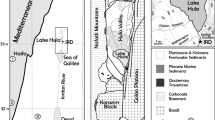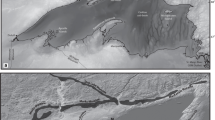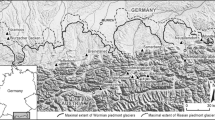Abstract
Geomorphology of a beach-ridge complex and adjacent lake basins along the northern shore of Lake Michigan records fluctuations in the level of Lake Michigan for the last 8000 to 10 000 14C yr B.P. (radiocarbon years Before Present). A storm berm at 204.7–206 m (671.6–675.9 ft) exposed in a sandpit provides evidence of a pre-Chippewa Low lake level that is correlated with dropping water levels of Glacial Lake Algonquin (c. 10 300–10 100 14C yr B.P.). Radiocarbon dates from organic material exposed in a river cutbank and basal sediments from Elbow Lake, Mackinac Co., Michigan, indicate a maximum age of a highstand of Lake Michigan at 6900 14C yr B.P., which reached as high as 196.7 m (645 ft), during the early-Nipissing transgression of Lake Michigan. Basal radiocarbon dates from beach swales and a second lake site (Beaverhouse Lake, Mackinac Co.) provide geomorphic evidence for a subsequent highstand which reached 192.6 m (632 ft) at 5390±70 14C yr B.P.
Basal radiocarbon dates from a transect of sediment cores, along with tree-ring data, and General Land Office Surveyor notes of a shipwreck, c. A.D. 1846, reveal a late-Holocene rate for isostatic rebound of 22.6 cm/100 radiocarbon years (0.74 ft/100 radiocarbon years) for the northern shore of Lake Michigan, relative to the Lake Michigan-Lake Huron outlet at Port Huron, Michigan. Changes in sediment stratigraphy, inter-ridge distance, and sediment accumulation rates document a mid- to late-Holocene retreat of the shoreline due to isostatic rebound. This regression sequence was punctuated by brief, periodic highstands, resulting in progressive development over the past 5400 14C yr of 75 pairs of dune ridges and swales each formed over an interval of approximately 72 years. Times of lake-level fluctuation were identified at 3900, 3200, and 1000 14C yr B.P. based on changes in inter-ridge spacing, shifts in the course of Millecoquins River, and reorientation of beach-ridge lineation. Soil type, dune development, and selected pollen data provide supporting evidence for this chronology. Late-Holocene beach-ridge development and lake-level fluctuations are related to a retreat of the dominant Pacific airmass and the convergence of the Arctic and Tropical airmasses resulting in predominantly meridional rather than zonal air flow across the Great Lakes region.
Similar content being viewed by others
References
Andrews, J. T., 1970. A Geomorphological Study of Post-glacial Uplift with Particular Reference to Arctic Canada. Alden Press, Oxford, 156 pp.
Baedke, S. J. & T. A. Thompson, 1993. Preliminary report of late Holocene lake-level variation in northern Lake Michigan: Part 1. U.S.G.S. Open file report 93–4, Indiana University, Bloomington, 16 pp.
Barkhausen, H. N., 1991. The Riddle of the Naubinway Sands: A Report on the Millecoquins River Wreck. The Association for Great Lakes Maritime History, Manitowoc, WI.
Bames, B. V. & W. H. Wagner, 1981. Michigan Trees. University of Michigan Press, Ann Arbor, 383 pp.
Bartlein, P. J., T. WebbIII & E. C. Fleri, 1984. Holocene climate change in the northern Midwest: pollen-derived estimates. Quat. Res. 22: 361–374.
Bemabo, J. C., 1981. Quantitative estimates of temperature change over the last 2700 years in Michigan based on pollen data. Quat. Res. 15: 143–159.
Bishop, C. T., 1990. Historical variation of water levels in lakes Erie and Michigan-Huron. J. Great Lakes Res. 16: 406–425.
Brubaker, L. B., 1975. Postglacial forest patterns associated with till and outwash in northcentral Upper Michigan. Quat. Res. 5: 499–527.
Bryson, R. A. & K. Hare, 1974. The climates of North America. In R. A. Bryson & K. Hare (eds), Climates of North America. World Survey of Climatology 11, Elsevier Scientific Publishing Co., N.Y., 1–47.
Chrzastowski, M. J., F. A. Pranschke & C. W. Shabica, 1991. Discovery and preliminary investigations of the remains of an early Holocene forest on the floor of southern Lake Michigan. J. Great Lakes Res. 17: 543–552.
Clark, J. A., H. S. Pranger II, J. K. Walsh & J. A. Primus, 1990. A numerical model of glacial isostasy in the Lake Michigan basin. In A. F. Schneider & G. S. Fraser (eds), Late Quaternary History of the Lake Michigan Basin. Geological Society of America, Special Paper 251: 111–123.
Clark, P. U., 1994. Unstable behavior of the Laurentide Ice Sheet over deforming sediment and its implication for climate change. Quat. Res. 41: 19–25.
Clark, R. H. & N. P. Persoage, 1970. Some implications of crustal movement in engineering planning. Can. J. Earth Sci. 7: 628–633.
Davis, M. B., 1967. Late-glacial climate in northern United States: A comparison of New England and the Great Lakes region. In E. J. Cushing & H. E. WrightJr., (eds), Quaternary Paleoecology. Yale University Press, New Haven: 11–43.
Davis, M. B., K. D. Woods, S. L. Webb & R. P. Futyma, 1986. Dispersal versus climate: Expansion of Fagus and Tsuga in the Upper Great Lakes region. Vegetatio 67: 93–103.
Dean, W. E.Jr., J. P. Bradbury, R. Y. Anderson & C. W. Barnosky, 1984. The variability of Holocene climate change: evidence from varved lake sediments. Science 226: 1191–1194.
Denton, S. R. & B. V. Barnes, 1987. Spatial distribution of ecologically applicable climatic statistics in Michigan. Can. J. Forest Resour. 17: 598–612.
Dorr, J. A. & D. F. Eschman, 1970. Geology of Michigan. University of Michigan Press, Ann Arbor, 476 pp.
Dott, E. R., 1990. Stratigraphy and lake level history of a beach ridge complex at Two Rivers, Wisconsin, on the northwest shore of Lake Michigan. Master's thesis, Department of Geology, University of Wisconsin, Madison, WI, 222 pp.
Dreimanis, A., 1977. Late Wisconsin glacial retreat in the Great Lakes Region, North America. Annals of the New York Academy of Sciences 288: 70–89.
Faegri, K. & J. Iversen, 1975. Textbook of Pollen Analysis. Hafner Press, N. Y., 295 pp.
Farrand, W. R., 1962. Post-glacial uplift in North America. American J. Sci. 260: 181–199.
Farrand, W. R., 1982. Map of the Quaternary Geology of Northern Michigan, 1:500 000. Michigan Department of Natural Resources and Michigan Geological Survey.
Farrand, W. R., D. M. Mickelson, W. R. Cowan & J. E. Goebel, 1984. Quaternary Geologic Map of the Lake Superior Quadrangle, United States and Canada. Quaternary Geologic Atlas of the United States, Miscellaneous Investigations Series Map I-1420 (NL-16).
Farrand, W. R. & C. W. Drexler, 1985. Late Wisconsin and Holocene history of the Lake Superior Basin. In P. F. Karrow & P. E. Calkin (eds), Quaternary Evolution of the Great Lakes. Geological Association of Canada Special Paper 30: 17–32.
Fassett, N. C., 1940. A Manual of Aquatic Plants. University of Wisconsin Press, Madison, 405 pp.
Fraser, G. S., C. E. Larsen & N. C. Hester, 1990. Climate control oflake levels in the Lake Michigan and Lake Huron basins. In A. F. Schneider & G. S. Fraser (eds), Late Quaternary History of the Lake Michigan Basin. Geological Society of America, Special Paper 251: 75–90.
Futyma, R. P., 1981. The northern limits of glacial lake Algonquin in Upper Michigan. Quat. Res. 15: 291–310.
Futyma, R. P., 1982. Post-glacial vegetation of eastern Upper Michigan. Ph.D. dissertation, University of Michigan, Ann Arbor, MI, 426 pp.
Futyma, R. P. & N. G. Miller, 1986. Stratigraphy and genesis of the Lake Sixteen peatland, northern Michigan. Can. J. Bot. 64: 3008–3019.
Goldthwait, J. W., 1908. A reconstruction of water planes of the extinct glacial lakes in the Lake Michigan basin. J. of Geol. 16: 459–476.
Hansel, A. K., D. M. Mickelson, A. F. Schneider & C. E. Larsen, 1985. Late Wisconsinan and Holocene history of the Lake Michigan basin. In P. F. Karrow & P. E. Calkin (eds), Quaternary Evolution of the Great Lakes. Geological Association of Canada, Special Paper 30: 39–53.
Hough, J. L., 1958. Geology of the Great Lakes. University of Illinois Press, Urbana, 313 pp.
Ives, W., 1849. Field notes of William Ives, deputy surveyor, July 23rd, 1849, from Sec. 30, Township 43 North, Range 9 West, as recorded in Register of Deeds, St. Ignace, Mackinac County, MI.
Johnson, T. C., R. D. Stieglitz & A. M. Swain, 1990. Age and paleoclimatic significance of Lake Michigan beach ridges at Bailey's Harbor, Wisconsin. In A. F. Schneider & G. S. Fraser (eds), Late Quaternary History of the Lake Michigan Basin. Geological Society of America, Special Paper 251: 67–74.
Johnson, W. H., 1986. Stratigraphy and correlation of the glacial deposits of the Lake Michigan Lobe prior to 14 ka B.P. In V. Sibrava, D. Q. Bowen & G. M. Richmond (eds), Quaternary Glaciations in the Northern Hemisphere. Quat. Sci. Rev. 5: 17–22.
Jowsey, P. C., 1966. An improved peat sampler. New Phytologist 65: 245–248.
Karrow, P. F. & P. E. Calkin (eds), 1985. Quaternary Evolution of the Great Lakes. Geol. Assoc. Canada, Special Paper 30, 258 pp.
Knox, J. C., 1985. Response of floods to Holocene climate change in the Upper Mississippi Valley. Quat. Res. 23: 287–300.
Lambert, J. L. & F. D. Hole, 1971. Hydraulic properties of an ortstein horizon. Soil Sci. Soc. America, Proceedings 35: 785–787.
Larsen, C. E., 1985. Lake level, uplift, and outlet incision, the Nipissing and Algoma Great Lakes. In P. F. Karrow & P. E. Calkin (eds), Quaternary Evolution of the Great Lakes. Geological Associations of Canada, Special Paper 30: 63–78.
Larsen, C. E., 1987. Geological History of Glacial Lake Algonquin and the Upper Great Lakes. United States Geol. Survey Bull. 1801, 36 pp.
Larsen, C. E., 1994. Beach ridges as monitors of isostatic uplift in the upper Great Lakes. J. Great Lakes Res. 20: 108–134.
Leverett, F., 1897. The Pleistocene features and deposits in the Chicago area. Chicago Acad. Sci. Bull. 2, 85 pp.
Leverett, F. & F. B. Taylor, 1915. The Pleistocene of Indiana and Michigan and the history of the Great Lakes. United States Geological Survey Monograph 53, 529 pp.
Lewis, C. F. M., 1969. Late Quaternary history of the lake levels in the Huron and Erie basins. 12th Conference on Great Lakes Research, Ann Arbor, MI. Proceedings, Int. Assoc. for Great Lakes Res.: 147–148.
Lewis, C. F. M., 1970. Recent uplift of Manitoulin Island, Ontario. Can. J. Earth Sci. 7: 665–675.
Lewis, C. F. M. & T. W. Anderson, 1989. Oscillations of levels and cool phases of the Laurentian Great Lakes caused by inflows from glacial Lakes Agassiz and Barlow-Ojibway. J. Paleolimnol. 2: 99–146.
Martin, H. M., 1957. Map of the surface formations of Northern Michigan. Michigan Geological Survey Publication 49. Michigan Department of Conservation.
Mayewski, P. A., G. H. Denton & T. J. Hughes, 1981. Late Wisconsin ice sheets in North America. In G. H. Denton & T. J. Hughes (eds). The Last Great Ice Sheets. J. Wiley & Sons, New York: 67–178.
Munsell, Color, 1975. Munsell Color Charts. MacBeth Division of the Kollmorgan Corporation, Baltimore, Unpaginated.
Olson, J. S., 1958. Lake Michigan dune development. 3. Lake-level, beach, and dune oscillations. J. Geol. 66: 473–483.
Petty, W. H., 1994. Holocene uplift and vegetation change along the northern shore of Lake Michigan. M.S. Thesis, University of Tennessee, Knoxville, TN, 171 pp.
Phillips, B. A. M., 1977. Shoreline inheritance in coastal histories. Science 195: 11–16.
Schneider, A. F. & G. S. Fraser (eds), 1990. Late Quaternary History of the Lake Michigan Basin. Geological Society of America, Special Paper 251, 123 pp.
Stanley, G. M., 1938. The submerged valley through Mackinac Straits. J. Geol. 46: 966–974.
Teller, J. T. & L. Clayton, (eds), 1983. Glacial Lake Agassiz. Geological Association of Canada Special Paper 26, 451 pp.
Thwaites, F. T. & K. Bertrand, 1957. Pleistocene geology of the Door Peninsula, Wisconsin. Geol. Soc. Am. Bull. 68: 831–879.
Thompson, T. A., 1987. Ph. D. dissertation, University of Indiana, Bloomington, IN, 129 pp.
Thompson, T. A., 1992. Beach-ridge development and lake-level variation in southern Lake Michigan. Sed. Geol. 80: 305–318.
U.S. Geological Survey, 1982. National High Altitude Photography (NHAP) Project. United States Geological Survey, Reston, VA.
Walcott, R. I., 1970. Isostatic response to loading of the crust in Canada. Can. J. Earth Sci. 7: 716–727.
Webb, T.III, P. J. Bartlein, S. P. Harrison & K. H. Anderson, 1993. Vegetation, lake levels, and climate in eastern North America for the past 18 000 years. In H. E. WrightJr., J. E. Kutzbach, T. WebbIII, W. F. Ruddiman, F. A. Street-Perrot & P. J. Bartlein (eds), Global Climates Since the Last Glacial Maximum, University of Minnesota Press, Minneapolis: 415–467.
Williams, A. S., 1974. Late-glacial—Post-glacial Vegetation History of the Pretty Lake Region, Northeastern Indiana. Geological Survey Professional Paper 686-B: B1–B28.
Winkler, M. G., A. M. Swain & J. E. Kutzbach, 1986. Middle Holocene dry period in the northern midwestern United States: Lake levels and pollen stratigraphy. Quat. Res. 25: 235–250.
Wright, H. E., 1967. A square-rod piston sampler for lake sediments. J. Sed. Petrol. 37: 975–976.
Wright, H. E., 1976. The dynamic nature of Holocene vegetation: a problem in paleoclimatology, biogeography, and stratigraphic nomenclature. Quat. Res. 6: 581–596.
Author information
Authors and Affiliations
Rights and permissions
About this article
Cite this article
Petty, W.H., Delcourt, P.A. & Delcourt, H.R. Holocene lake-level fluctuations and beach-ridge development along the northern shore of Lake Michigan, USA. J Paleolimnol 15, 147–169 (1996). https://doi.org/10.1007/BF00196778
Received:
Accepted:
Issue Date:
DOI: https://doi.org/10.1007/BF00196778




